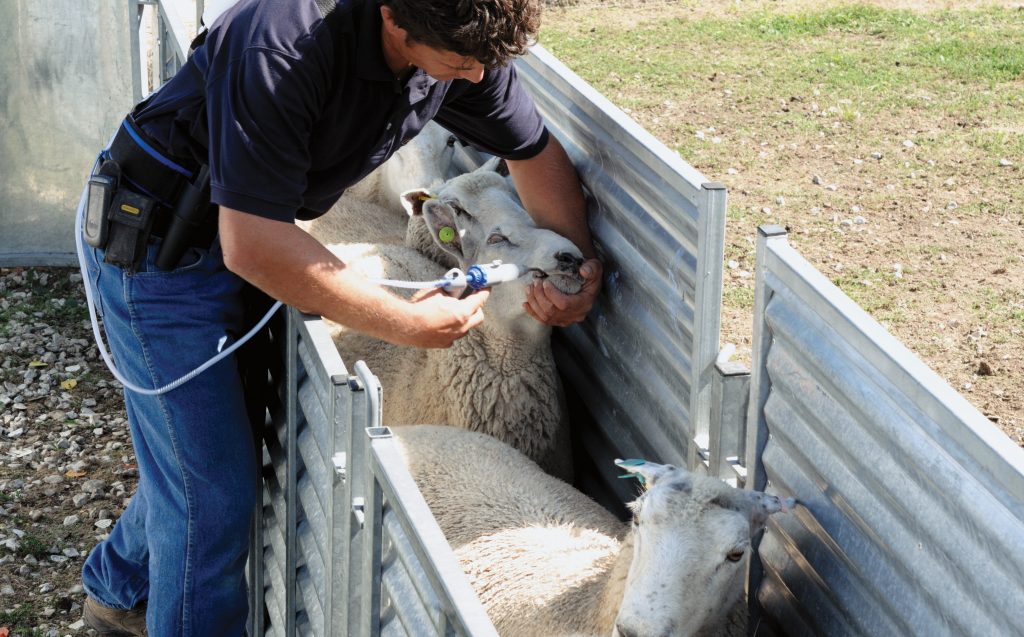Abortion in Sheep
By G.F. Kennedy, DVM — Pipestone Veterinary Services

There are three major infectious causes of abortion in sheep:
- Enzootic abortion caused by Chlamydia psittici
- Vibrio abortion caused by Campylobacter sp.
- Toxoplasma abortion caused by Toxoplasma gondi.
There are control procedures that can be utilized to combat all of these abortion challenges.
Enzootic abortion can be controlled by vaccination and feeding antibiotics. Vaccine is available and should be given 60 and 30 days prior to breeding, and in previously vaccinated ewes 30 days prior to breeding. Tetracycline antibiotics may be administered in the feed at the rate of 300 mg per head per day throughout the breeding season and gestation period. I would prefer to pulse feed tetracycline at the rate of 800 to 1000 mg per head for five days every two weeks. This procedure has proved to be more effective. In my own flock, I don’t do any preventive measures. In the upper Midwest it is seldom found and when it is found it is in ewes that have been imported from Western range states. Preventive programs do need to be in place for Western ewes.
Vibrio abortion should be controlled by vaccination. I prefer the vaccine made by Hygeia as it contains the tetracycline resistant Jejuni stain that has been a problem. Vibrio vaccination should be done at 30 days prior to breeding and again at mid gestation. Previously vaccinated ewes need only to be done at mid gestation. The feeding of tetracycline is much less effective due to bacterial resistance.
Vibrio is a systemic disease in sheep that may result in abortion. They get infected by ingesting the Vibrio bacteria. In cattle, it is a venereal disease. Cattle vaccine doesn’t work on sheep and visa versa.
There are several options on preventing toxoplasmosis. The disease is caused by coccidiosis of cats and kittens are the most likely source. Defecation in grain or hay is a source of infection. A thimble of infected cat feces can infect a hundred sheep or more. The solution to keep no cats around is not the right one. If sheep are exposed when not pregnant it is a non-event and immunity develops and it is not an issue going forward. When cats defecate in a feed bunk, I make it a point to feed that material to non-pregnant ewes. In Australia, they once had a live oral vaccine that they used. Avoid feeding a known contaminated feed source to pregnant ewes. The point is we don’t always know, but with the absence of cats on the premises sheep become very susceptible.
Rumensin may be fed at the rate of 15mg per head per day to prevent. Deccox 6%, two pounds can be mixed with fifty pounds of salt, no sheep mineral should be fed in addition. Selenium and iodine in salt mix should be adequate. There are reports of sheep being infected on pastures and Deccox is about the only option in those situations.
To determine an outbreak (and I think there should be concern when the rate exceeds three percent) fetuses and placenta should be submitted to a diagnostic lab to determine cause. Cause cannot be determined by clinical observation. Diagnosis may be essential for treatment and always essential in planning for next year.
My shot gun approach early on with no diagnosis is to feed one pound of 2 gram AS700 crumbles for five head for five days and repeat every two weeks.
Goats are somewhat a different story. Vibrio is not a major problem but Lepto may be. You can vaccinate for Lepto. Chlamydia and Toxo affect goats similar to sheep.
Have a question about sheep or goats?
Thousands of producers all over the country use Premier 1 Supplies because of our well-trained staff and accurate, friendly answers. We want to help you succeed with your sheep operation.


